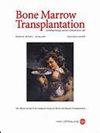血液系统恶性肿瘤的同种异体造血干细胞移植:使用抗T淋巴细胞免疫球蛋白代替抗胸腺细胞球蛋白进行体内T细胞耗竭的新型调理方案。
IF 4.5
2区 医学
Q1 HEMATOLOGY
引用次数: 0
摘要
我们对312名血液系统恶性肿瘤患者的单倍体干细胞移植(haplo-SCT)新方案的安全性和有效性进行了评估。该方案由北京平台演变而来,用ATLG取代了ATG,增加了氟达拉滨,取消了阿糖胞苷和司莫司汀。移植后的 GVHD 预防结合了 Basiliximab 和低剂量环磷酰胺;总体而言,调理持续时间缩短了。中性粒细胞和血小板恢复的中位时间均为11天。0.96%的患者发生了移植物排斥反应。截至第200天,II-IV级和III-IV级急性GVHD的累计发生率分别为35.3%和8.9%。2年后出现完全和广泛慢性GVHD的概率分别为40.7%和14.7%。35.6%的患者出现CMV病毒血症,100天内CMV肺炎发病率为1.9%,无CMV相关死亡病例。100天、1年和2年的非复发死亡率累积发生率分别为2.9%、4.4%和6.6%。4年的OS、RFS和GRFS分别为78.9%、70.7%和47.3%。受者年龄越大,NRM越高,而移植前MRD阳性则预示着更差的OS、RFS和更高的复发率。我们的单倍体造血干细胞移植新方案感染率低,移植失败、严重GVHD和死亡率的风险可接受,是一种安全有效的单倍体移植策略。本文章由计算机程序翻译,如有差异,请以英文原文为准。

Haploidentical hematopoietic stem cell transplantation for hematologic malignancies: a novel conditioning regimen with anti-T lymphocyte immunoglobulin instead of anti-thymocyte globulin for in vivo T cell depletion
We evaluated the safety and efficacy of a novel protocol for haploidentical stem cell transplantation (haplo-SCT) in 312 patients with hematologic malignancies. The protocol evolved from the Beijing platform replacing ATG with ATLG; adding Fludarabine and removing cytarabine and Simustine. GVHD prophylaxis combined Basiliximab and low-dose cyclophosphamide post-transplant; overall, the conditioning duration was shortened. Median times to neutrophil and platelet recovery were both 11 days. Graft rejection occurred in 0.96% of patients. Cumulative incidences of grades II–IV and III–IV acute GVHD by day 200 were 35.3% and 8.9%, respectively. Probabilities of total and extensive chronic GVHD at 2 years were 40.7% and 14.7%. CMV viremia was observed in 35.6% of patients, with a 1.9% 100-day CMV pneumonia incidence and no CMV-related mortality. Cumulative incidences of non-relapse mortality at 100 days, 1 year, and 2 years were 2.9, 4.4, and 6.6%. The 4-year OS, RFS, and GRFS rates were 78.9, 70.7, and 47.3%. Older recipient age was associated with higher NRM, while positive pre-transplant MRD predicted worse OS, RFS, and higher relapse incidence. Our novel protocol for haplo-SCT is associated with low infection rates and acceptable risks of graft failure, severe GVHD, and mortality, representing a safe and effective haploidentical transplantation strategy.
求助全文
通过发布文献求助,成功后即可免费获取论文全文。
去求助
来源期刊

Bone Marrow Transplantation
医学-免疫学
CiteScore
8.40
自引率
8.30%
发文量
337
审稿时长
6 months
期刊介绍:
Bone Marrow Transplantation publishes high quality, peer reviewed original research that addresses all aspects of basic biology and clinical use of haemopoietic stem cell transplantation.
The broad scope of the journal thus encompasses topics such as stem cell biology, e.g., kinetics and cytokine control, transplantation immunology e.g., HLA and matching techniques, translational research, and clinical results of specific transplant protocols. Bone Marrow Transplantation publishes 24 issues a year.
 求助内容:
求助内容: 应助结果提醒方式:
应助结果提醒方式:


